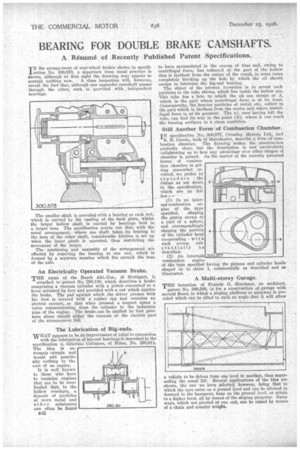BEARING FOR DOUBLE BRAKE CAMSHAFTS.
Page 30

If you've noticed an error in this article please click here to report it so we can fix it.
A Résumé of Recently Published Patent Specifications.
IN the arrangmlent of rear-wheel brakes shown in specification No. 300,878, a departure from usual practice is shown, although at first sight the drawing may appear to contain nothing new. A close inspection will, however, reveal the fact that, although one expander camshaft passes through the other, each is provided with independent bearings.
The smaller shaft is provided with a bearing at each end, which is carried by the casting of the back plate, whilst . the larger hollow shaft is carried by bearings held in a larger boss. The specification points out that, with the usual arrangement, where one shaft takes its bearing in the bore of the other shaft, considerable friction is set up when the inner ehaft is operated, thus restricting the movement of the larger.
The ' machining and 'assembly of the arrangement are effected by removing the bearing at one end, which is formed by a separate member which fits around the boss of the axle.
An Electrically Operated Vacuum Brake.
THE name of the Bosch Akt.-Ges., of Stuttgart, is
attached to patent No.' 298,1i0, which describes a brake comprising a vacuum cylinder with a pistOn connected to a lever actuated by foot and provided with a rod which 'applies the brake. The pad against which the driver presses with his foot is covered .with. a _rubber cap Mid contains an electric contact, so that when pressed, a magnet opens a valve communicating from the cylinder to the induction pipe of the engine. The brake can be applied by feet pressure alone should either the vacuum or the electric part of the arrangement fail.'
The Lubrication of Big-ends.
WHAT appears to be an improvement of value in connection It is well known to those who have to exandne engines that are to be overhauled that, in the hollow crankpin, a deposit of particles of worn metal and other substances can often be found to have accumulated in the course of time and, owing, to centrifugal force, has collected at the part of the hollow that is farthest from the centre of the crank, in some Csies completely blocking up the hole by which the oil should escape to lubricate the big-end bearing: The object of the Present invention is to arrest such particles in the tube shown, which lies inside the hollow pin. ' This tube has a hole by -which the oil can escape at A, which is the part where 'centrifugal force is at its least. Consequently, the heavier particles of metal, etc., collect in the part which is farthest from the centre and where centrifugal force is at its greatest.' The oil, once having left the tube, can find its way to the point (B), where it can reach the bearing surfaces in a clean condition.
Still Another Form of Combustion Chamber.
IN specification No. 300,877, Crossley Motors, Ltd., and
S. E. Crooke, both of Manchester, describe .a form of combustion chamber. The drawing makes the construction perfectly clear, but the description is not particularly enlightening as to how any advantage over other shapes of chamber is gained. As the matter of the recently patented forms of combustion chamber is getting somewhat involved, we prefer to reproduce the claims as set down in the specification, which are as fol.1ovi (1) In an internal-combustion engine of the type
specified, shaping -the piston crown to a part of a sphere, and correspondingly shaping the portion of the cylinder head cooperating . with such crown, substantially as described.
(2). An . internals combustion engine of the type specified having the pistons and cylinder heads shaped as in claim 1, substantially as, described and as
illustrated.
: . A Multi-storey Garage.
THE invention of Francis 0. Merchant, an architect, pateilt -No. 299,508,• is for a construction of garage with several floors, in which a sloping platferni Or gangway is provided Which can be tilted to such an angle that it will allow
a vehicle to be driven from one level to another, thus superseding the usual lift. Several applications of the idea are shown, the one we have selected, however, being that in which the cars enter on a ground level and can be allowed to descend to the basement, keep on the ground level, or attain to a higher level, all by means of the sloping gangway. Gangways, which are pivoted at one end, can be raised by means of a chain and counter weight.






























